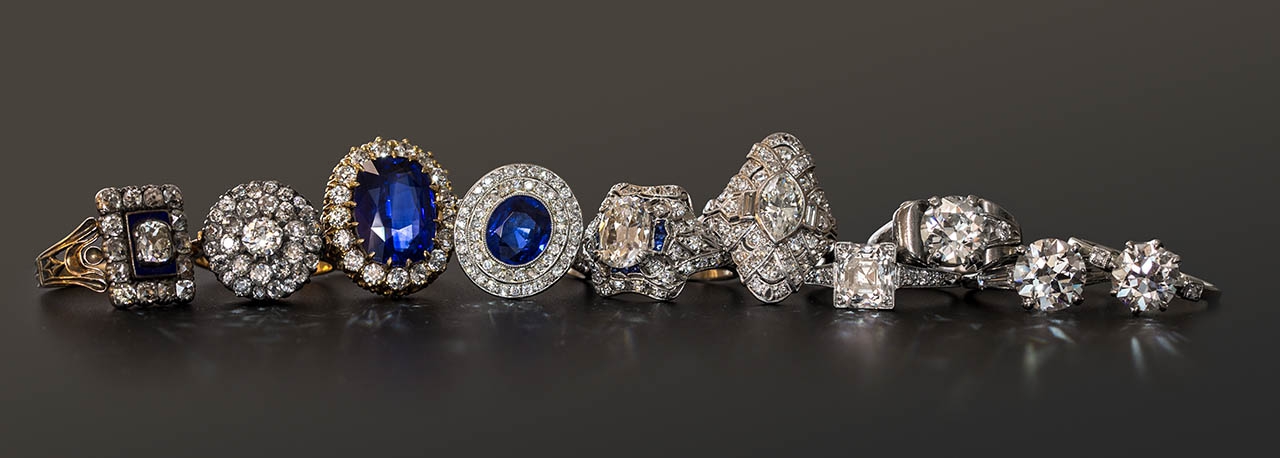Contact us to speak with a jewelry concierge today
Decorative Style Periods

Search

Georgian
The Georgian period is named after the successive English King Georges I through IV, and generally covers between 1714 and 1837, although as with all decorative styles, absolute fixed dates do not pertain. Georgian jewels are the earliest that we have in our collection and original pieces are very rare and collectable. However, due to their age and delicacy, Georgian jewels are not recommended for everyday wear.
Most Georgian Jewelry available today is from the early 1800s and is characterized by highly dimensional repousse designs. Floral and scroll motifs are typical and commonly used gemstones include semi-precious colored stones, garnets chief among them, and early faceted rose-cut and table-cut diamonds. These were often enhanced by foil-back settings, creating the beloved fire, which was best appreciated under candlelight. Standards for gold in the Georgian era were usually 18 karat and higher, giving the finished jewels a lovely rich luster.
Read full AJU article on Georgian Jewelry.
Victorian
The Victorian Period generally covers 1837 through 1901 and is named for Queen Victoria, the reigning monarch who was reputedly an incurable romantic. Victorian Jewels virtually drip with sentimentality and symbolism, and of all the decorative periods Victorian incorporates the most varied and eclectic design motifs: flowers, birds, snakes, hearts and crescents, to name just a handful. Victorian jewelry incorporate as many gemstones as were available at the time, from humble agate, turquoise, seed pearls and coral all the way to lavish diamond studded showstoppers. They are composed almost exclusively of yellow gold and are often topped with silver to accentuate the diamonds.
Read full AJU article on Victorian Jewelry.
Art Nouveau
The relatively brief Art Nouveau period (approximately 1895 through 1915) produced some of the most distinctive and delightful jewels off all time. Fantastical female forms: dancers, nymphs and mermaids were frequently combined with sinuous, nature inspired design motifs: flowers, water lilies, dragonflies, and the ubiquitous whiplash motif. The jewelers’ art and imagination trumped prominent gemstones and diamonds, which were modestly employed mostly for accent in Art Nouveau jewelry. Shimmering colors were applied with fired enamels and occasionally with plique à jour, translucent enamel evoking stained glass windows.
Read full AJU article on Art Nouveau Jewelry.
Edwardian
Delicate, romantic, feminine and lacy well describes jewels of the Edwardian era. Named after the brief reign of King Edward (1901-1910), Edwardian jewelry is usually rendered platinum, or platinum over gold, and represent some of the most exquisite and intricately detailed pieces extant. Delicate piercing lends a light and airy look and feel to curvaceous, open designs. Diamond studded bows and garlands frequently embellish central diamonds, pastel colored gemstones, and natural pearls. For good reason the corresponding design period in France is called La Belle Époque (The Beautiful Era).
Read full AJU article on Edwardian Jewelry.
Art Deco
The roaring twenties inaugurated the Art Deco design period, which lasted all the way through the Depression-era years of the 1930s. Modernity made its mark with bold, streamlined, geometric statements (think Empire State, Chrysler Building and Golden Gate Bridge), which translated beautifully into striking and sophisticated jewelry designs. Platinum reigned supreme to showcase fine white diamonds, which were often accented with calibre sapphires or black onyx. Diamond and vibrant colored gemstone rings, and elongated dinner rings, were complimented with opulent bracelets stacked on both wrists, and double clip brooches and sautoir length necklaces were all the rage.
Read full AJU article on Art Deco Jewelry.
Retro
Like Art Nouveau, the Retro jewelry period is both highly distinctive and relatively short lived. Because platinum was needed as a strategic metal during WWII, the jewelry the 1940s made a sudden turn to rose and rosy-yellow gold. The bold dramatic designs that distinguish Retro jewels immediately evoke the style and glamour of Golden Age Hollywood: Joan Crawford, Greta Garbo, Marlena Dietrich and Rita Hayworth. There is nothing subtle or demure about it. Over-sized Art Deco-inspired creations, but very often asymmetrical and whimsical, featured rubies and diamonds but also many semi-precious stones such as citrine, aquamarine, amethyst and moonstones in large sizes.
Read full AJU article on Retro Jewelry.
Mid-Century
Mid-Century jewelry as in the Fabulous Fifties (and into the early-60s)! From Mamie Eisenhower to Elizabeth Taylor to Marilyn Monroe! We are back to platinum and diamonds but seemingly in direct opposition to prewar Art Deco style. Lots of abstract, free-form, and floral designs with overlapping and pave diamonds. Brooches and cocktail rings aplenty. More flash than finesse, but lots of impressive, showstopping sparklers.
Read full AJU article on Fifties Jewelry.
The Sixties
The mid-to-late sixties may evoke counter culture rebellion and Rock n’ Roll, but in terms of the more artful jewelry it was the late mid-century modern, pop-art, mod and hippie aesthetics that made an impact. Wild works of wearable art, mostly free of any fine and larger diamonds and gemstones, made a fleeting appearance. Lots of asymmetrical, geometrical, Mondrian inspired expressions incorporating colorful turquoise, lapis, malachite, tiger-eye and onyx inlays, predominantly in yellow gold.